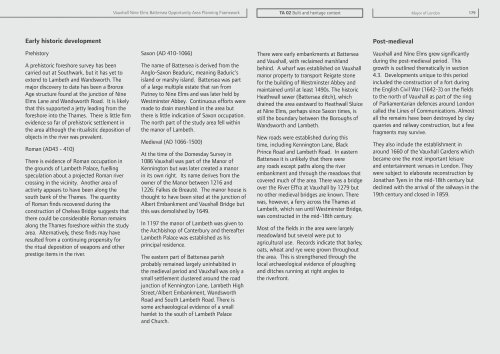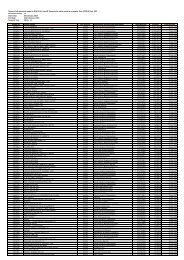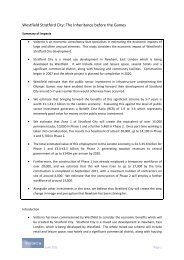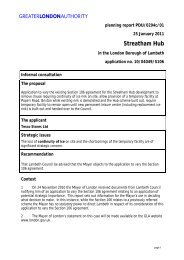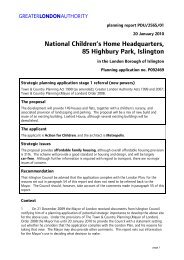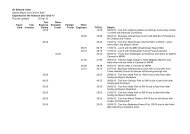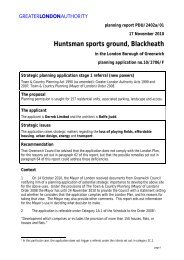Vauxhall Nine Elms Battersea Opportunity Area Planning Framework
Vauxhall Nine Elms Battersea Opportunity Area Planning Framework
Vauxhall Nine Elms Battersea Opportunity Area Planning Framework
You also want an ePaper? Increase the reach of your titles
YUMPU automatically turns print PDFs into web optimized ePapers that Google loves.
<strong>Vauxhall</strong> <strong>Nine</strong> <strong>Elms</strong> <strong>Battersea</strong> <strong>Opportunity</strong> <strong>Area</strong> <strong>Planning</strong> <strong>Framework</strong>TA 02 Built and heritage contextMayor of London 179Early historic developmentPost-medievalPrehistoryA prehistoric foreshore survey has beencarried out at Southwark, but it has yet toextend to Lambeth and Wandsworth. Themajor discovery to date has been a BronzeAge structure found at the junction of <strong>Nine</strong><strong>Elms</strong> Lane and Wandsworth Road. It is likelythat this supported a jetty leading from theforeshore into the Thames. There is little firmevidence so far of prehistoric settlement inthe area although the ritualistic deposition ofobjects in the river was prevalent.Roman (AD43 - 410)There is evidence of Roman occupation inthe grounds of Lambeth Palace, fuellingspeculation about a projected Roman rivercrossing in the vicinity. Another area ofactivity appears to have been along thesouth bank of the Thames. The quantityof Roman finds recovered during theconstruction of Chelsea Bridge suggests thatthere could be considerable Roman remainsalong the Thames foreshore within the studyarea. Alternatively, these finds may haveresulted from a continuing propensity forthe ritual deposition of weapons and otherprestige items in the river.Saxon (AD 410-1066)The name of <strong>Battersea</strong> is derived from theAnglo-Saxon Beaduric, meaning Baduric’sisland or marshy island. <strong>Battersea</strong> was partof a large multiple estate that ran fromPutney to <strong>Nine</strong> <strong>Elms</strong> and was later held byWestminster Abbey. Continuous efforts weremade to drain marshland in the area butthere is little indication of Saxon occupation.The north part of the study area fell withinthe manor of Lambeth.Medieval (AD 1066-1500)At the time of the Domesday Survey in1086 <strong>Vauxhall</strong> was part of the Manor ofKennington but was later created a manorin its own right. Its name derives from theowner of the Manor between 1216 and1226: Falkes de Breauté. The manor house isthought to have been sited at the junction ofAlbert Embankment and <strong>Vauxhall</strong> Bridge butthis was demolished by 1649.In 1197 the manor of Lambeth was given tothe Archbishop of Canterbury and thereafterLambeth Palace was established as hisprincipal residence.The eastern part of <strong>Battersea</strong> parishprobably remained largely uninhabited inthe medieval period and <strong>Vauxhall</strong> was only asmall settlement clustered around the roadjunction of Kennington Lane, Lambeth HighStreet/Albert Embankment, WandsworthRoad and South Lambeth Road. There issome archaeological evidence of a smallhamlet to the south of Lambeth Palaceand Church.There were early embankments at <strong>Battersea</strong>and <strong>Vauxhall</strong>, with reclaimed marshlandbehind. A wharf was established on <strong>Vauxhall</strong>manor property to transport Reigate stonefor the building of Westminster Abbey andmaintained until at least 1490s. The historicHeathwall sewer (<strong>Battersea</strong> ditch), whichdrained the area eastward to Heathwall Sluiceat <strong>Nine</strong> <strong>Elms</strong>, perhaps since Saxon times, isstill the boundary between the Boroughs ofWandsworth and Lambeth.New roads were established during thistime, including Kennington Lane, BlackPrince Road and Lambeth Road. In eastern<strong>Battersea</strong> it is unlikely that there wereany roads except paths along the riverembankment and through the meadows thatcovered much of the area. There was a bridgeover the River Effra at <strong>Vauxhall</strong> by 1279 butno other medieval bridges are known. Therewas, however, a ferry across the Thames atLambeth, which ran until Westminster Bridge,was constructed in the mid-18th century.Most of the fields in the area were largelymeadowland but several were put toagricultural use. Records indicate that barley,oats, wheat and rye were grown throughoutthe area. This is strengthened through thelocal archaeological evidence of ploughingand ditches running at right angles tothe riverfront.<strong>Vauxhall</strong> and <strong>Nine</strong> <strong>Elms</strong> grew significantlyduring the post-medieval period. Thisgrowth is outlined thematically in section4.3. Developments unique to this periodincluded the construction of a fort duringthe English Civil War (1642-3) on the fieldsto the north of <strong>Vauxhall</strong> as part of the ringof Parliamentarian defences around Londoncalled the Lines of Communications. Almostall the remains have been destroyed by clayquarries and railway construction, but a fewfragments may survive.They also include the establishment inaround 1660 of the <strong>Vauxhall</strong> Gardens whichbecame one the most important leisureand entertainment venues in London. Theywere subject to elaborate reconstruction byJonathan Tyers in the mid-18th century butdeclined with the arrival of the railways in the19th century and closed in 1859.


